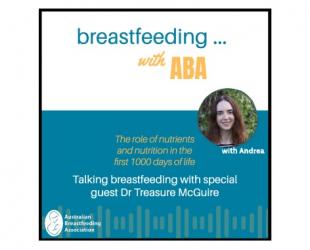Explore the science of breastmilk—what’s inside and why it matters for your baby.

Breastfeeding is the biologically normal way to feed babies. The composition of breastmilk sets the standard for human nutrition in early life.
Breastmilk contains many important factors that help protect your baby from illness and support the development of their immune system and a healthy gut.
How breastmilk changes to meet your baby’s needs
Breastmilk is always changing to give your baby what they need, right from the start. Its make-up shifts over time, from the very first days after birth and as your baby grows. Breastmilk changes during a single feed, from feed to feed and is unique for every mother and baby.1
The first milk you make, called colostrum, is packed with immune and growth factors to help protect your newborn. As your baby gets older, your milk adapts to meet your baby’s changing needs, offering the right mix of nutrients and protective elements at each stage. This means your breastmilk is specially suited to your baby, whether they’re born at term or early.2
Macronutrients
The main nutrients in breastmilk are fat, protein, and carbohydrate. Research shows that the overall amounts of these nutrients stays the same, even among women from different backgrounds and with different diets or levels of nutrition.3
On average, breastmilk contains about:
• 1.2 g/dL of protein
• 3.6 g/dL of fat
• 7.4 g/dL of lactose (the main carbohydrate)
The energy content of breastmilk is about 70 kilocalories per deciliter (kcal/dL), and this is mostly linked to how much fat is present.4
- Protein: The main proteins in breastmilk include casein, α-lactalbumin, lactoferrin, secretory immunoglobulin A (IgA), lysozyme, and serum albumin.5 These proteins support growth and immune function.6
- Fat: Fat is the most variable macronutrient in breastmilk. The concentration of fat increases as the breast is emptied. When the breast is very full, the milk has a lower fat content. As the breast empties during a feed, the fat content increases.7 The types of fatty acids in breastmilk reflect the mother’s diet, particularly long-chain polyunsaturated fatty acids such as omega-3s.8
- Carbohydrate: Lactose is the primary carbohydrate in breastmilk. Oligosaccharides, another significant group of carbohydrates, act as prebiotics and help protect against infection.9
Micronutrients – vitamins and minerals
Most breastfeeding mothers in Australia have adequate levels of vitamins and minerals in their milk. Only a few vitamins and minerals may need to be supplemented to make sure breastmilk has the right amounts.
Vitamin B12: Mothers who are vegan (and perhaps vegetarian) may need to take a vitamin B12 supplement,10 as this vitamin is mainly found in animal foods.
Vitamin D: If a mother has limited exposure to sunlight, or is at risk of vitamin D deficiency, a supplement may be needed.
Iodine: The National Health and Medical Research Council recommends that pregnant and breastfeeding women take an iodine supplement, as it can be hard to get enough from food alone.11
Bioactive and protective factors
Breastmilk contains more than nutrients—it’s packed with components that actively protect your baby and support healthy development. These include:
Living cells
Breastmilk carries immune cells such as white blood cells (leukocytes) and stem cells.12 Colostrum—the first milk—is especially rich in these cells, giving extra protection in the early days. Their numbers and types change as breastfeeding continues, but they remain part of breastmilk’s natural defense system, helping fight infection and support healthy growth.
Antibodies
Breastmilk is full of antibodies that help protect your baby from germs. The most important one is secretory IgA (sIgA). It coats your baby’s mouth, gut, and airways, helping block germs and reduce infection risk.6
Protective proteins
Proteins like lactoferrin and lysozyme help fight bacteria and viruses. Lactoferrin also binds iron, making it harder for harmful microbes to grow.13
Hormones and cytokines
Breastmilk contains tiny messengers called hormones and cytokines. They help your baby’s body work smoothly—supporting growth, guiding metabolism, and strengthening the immune system.
Growth factors
Growth factors in breastmilk help your baby’s body develop. They support a healthy gut, help blood vessels form, and play a role in brain and hormone development.14 These work together with other protective parts of breastmilk—like immune cells and antibodies—to keep your baby growing strong. Because they all act as a team, giving just one as a supplement can’t match the benefits of breastmilk itself.
Human Milk Oligosaccharides
HMOs are special carbohydrates found only in human breastmilk. They act as prebiotics, encouraging the growth of beneficial bacteria (probiotics) in your baby’s gut. They also act as ‘decoys’ to block harmful germs from attaching to your baby’s gut lining.15 There are more than 200 different HMOs, and their mix changes with each stage of lactation, making breastmilk uniquely suited to your baby’s needs.6
Breastmilk's microbiome
Breastmilk isn’t sterile—it has its own community of helpful microbes. These microbes may help shape your baby’s gut microbiome and support their health. Human milk oligosaccharides also play a role by encouraging the growth of good bacteria and influencing which microbes are present. Researchers are learning more about this milk microbiome. Early studies show that where you live and your environment can affect the types of bacteria and fungi in breastmilk. This is an exciting area of research, but what we know for sure is that breastmilk works in many ways to support your baby’s healthy start.16,17
Ongoing research
While much is known about the composition of breastmilk, research continues to identify new components and understand their functions. Breastmilk remains the reference standard for infant nutrition and immune support.
© Australian Breastfeeding Association November 2025
- Williams, J. E., Carrothers, J. M., Lackey, K. A., Beatty, N. F., Brooker, S. L., Peterson, H. K., Steinkamp, K. M., York, M. A., Shafii, B., Price, W. J., McGuire, M. A., & McGuire, M. K. (2019). Strong multivariate relations exist among milk, oral, and fecal microbiomes in mother–infant dyads during the first six months postpartum. The Journal of Nutrition, 149(6), 902–914. https//doi: 10.1093/jn/nxy299 .
- Bauer J, Gerss J (2011), Longitudinal analysis of macronutrients and minerals in human milk produced by mothers of preterm infants. Clin Nutr 30(2):215–220.
- Ballard O, Morrow AL (2013), Human Milk Composition: Nutrients and Bioactive Factors. Pediatr Clin North Am 60(1):49–74.
- Nommsen LA, Lovelady CA, Heinig MJ, Lonnerdal B, Dewey KG (1991), Determinants of energy, protein, lipid, and lactose concentrations in human milk during the first 12 mo of lactation: the DARLING Study. The American journal of clinical nutrition 53(2):457–465.
- Lonnerdal B (2004), Human milk proteins: key components for the biological activity of human milk. Advances in experimental medicine and biology 554:11–25.
- Andreas, N, Kampmann B, Le-Doare K. Human breast milk: a review on its composition and bioactivity. Early Hum Dev. 2015;91:629-635.
- Kent, J. C., Mitoulas, L. R., Cregan, M. D., Ramsay, D. T., Doherty, D. A., & Hartmann, P. E. (2006). Volume and frequency of breastfeeding and fat content of breast milk throughout the day. Pediatrics, 117(3), e387–e395.
- Martin MA, Lassek WD, Gaulin SJ, Evans RW, Woo JG, Geraghty SR, Davidson BS, Morrow AL, Kaplan HS, Gurven MD (2012), Fatty acid composition in the mature milk of Bolivian forager-horticulturalists: controlled comparisons with a US sample. Matern Child Nutr 8(3):404–418.
- Morrow AL, Ruiz-Palacios GM, Jiang X, Newburg DS (2005), Human-milk glycans that inhibit pathogen binding protect breast-feeding infants against infectious diarrhea. The Journal of nutrition 135(5):1304–1307.
- National Health and Medical Research Council. (2013). Australian dietary guidelines. https://www.nhmrc.gov.au/adg
- National Health and Medical Research Council (2010), Iodine supplementation for pregnant and breastfeeding women. URL: https://www.nhmrc.gov.au/about-us/publications/iodine-supplementation-p…
- Witkowska-Zimny M, Kaminska-El-Hassan E. Cells of human breast milk. Cell Mol Biol Lett. 2017;22:11.
- Lonnerdal, B. Bioactive proteins in human milk: health, nutrition and implications for infant formula. J Pediatr. 2016;173S:S4-S9. https//DOI: 10.1016/j.jpeds.2016.02.070
- Ballard, O., & Morrow, A. L. (2013). Human milk composition: Nutrients and bioactive factors. Pediatric Clinics of North America, 60(1), 49–74.
- Newburg DS, Ruiz-Palacios GM, Morrow AL (2005), Human milk glycans protect infants against enteric pathogens. Annual review of nutrition 25:37–58.
- Hunt KM, Foster JA, Forney LJ, Schutte UM, Beck DL, Abdo Z, Fox LK, Williams JE, McGuire MK, McGuire MA (2011), Characterization of the diversity and temporal stability of bacterial communities in human milk. PLoS ONE 6(6):e21313.
- Cabrera-Rubio R, Collado MC, Laitinen K, Salminen S, Isolauri E, Mira A (2012). The human milk microbiome changes over lactation and is shaped by maternal weight and mode of delivery. The American journal of clinical nutrition 96(3):544–551.



